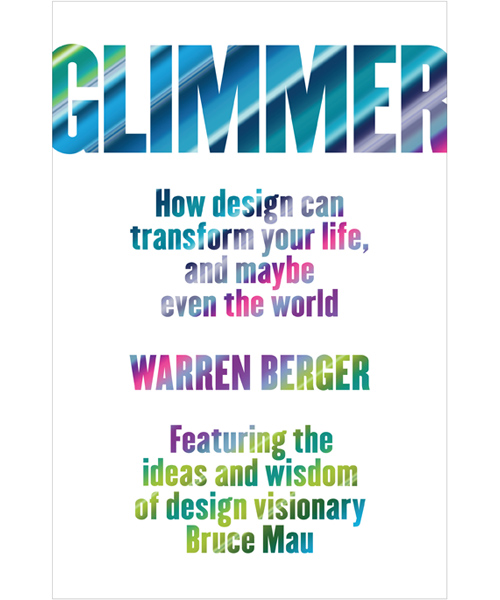
A new book arrived on my doorstep from Penguin called Glimmer: How Design Can Transform Your Life and Maybe Even the World by Warren Berger. The book seeks to discuss the “glimmer” moments in design: the moment when a new solution to an old problem is revealed. The book also features the insights of prominent designer Bruce Mau. The book goes beyond the how-to approach and looks at design as a cultural phenomenon — a force of change in today’s world. Berger speaks with over 200 leading design experts and discovers ten major principles of “design thinking”, which he outlines in the book. They include innovative ways to solve community problems and improving your creative flow.
Check out an excerpt from an interview with Berger below:
What is it that designers do that enables them to solve many different types of problems?
What designers do, first of all, is to question the way things work. Then they begin to reimagine the world we live in, and come up with new alternatives—fresh ways of doing things. This can run the gamut from a new way to peel a potato to a new way to design healthcare systems.
In the book, I take readers inside the design studio of Bruce Mau, while also profiling other designers, primarily to study how they approach problems—how they seek out new possibilities and bring them to life. So I interviewed, observed, and analyzed quite a few designers, including non-professionals who are designing everyday objects that solve problems. But the one designer that I really focus on is Mau.
Why Bruce Mau?
I chose Mau mainly because he’s an interesting character – a guy who grew up on a farm in rural Canada and emerged as a superstar in the design world. He’s an inspirational figure to a lot of young designers; many of them like to quote from Mau’s “manifesto” on how to live and work. But he’s also controversial within the design world. He’s very outspoken, and tends to talk about how design can save the world – which some people think is overly-ambitious. But whether or not you agree with everything he says, there’s a wonderful optimism that radiates from Bruce Mau — a sense that, with all the problems of the world right now, this is actually a great moment in time – a time of amazing possibilities. It’s a time when we, as a society and as individuals, can really design a better future. I think Glimmer embraces that optimistic spirit of Bruce Mau.
How did you come up with the 10 big design principles featured in the book?
As I studied lots of top designers, I discovered that there were some common principles they seem to share – even though these designers were working in very different disciplines, from product designers to graphic designers to people who design social services. They seemed to have in common certain core principles that guide them as they go through the design process. And these are principles we can all learn from—they can be applied to whatever challenges we may be trying to tackle, in business or in life. In fact, I found that I ended up using some of the design principles to help me work through the complex challenge of writing this book. Some of these principles came directly from Bruce Mau, some came from other designers. It’s my own attempt to create a unique “top 10” list of design principles. It should be said that there are many, many design principles, and I’m not saying these are the only ones. I was looking for principles that seemed to be the most widely shared by designers, but also ones that non designers could easily grasp. Finally I was looking for ideas that crossed over from business, to social issues, to personal life – because I wanted to cover all of those areas in the book.






